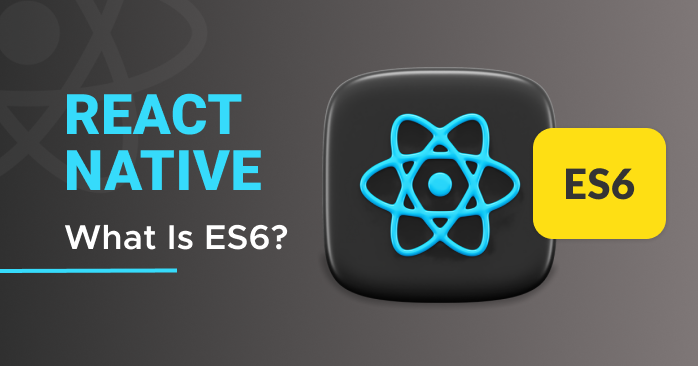Introduction
Over time, JavaScript has undergone substantial change, and ES6 (ECMAScript 6) was one of its most revolutionary updates.
Understanding ES6 is essential for React Native developers since it brings a number of improvements that make coding easier and more efficient. We’ll look at ES6, its significance, and how it improves React Native development in this post.
Table of Contents
React Native: What is ES6?
What is ES6?
The sixth iteration of the ECMAScript language specification is called ES6, or ECMAScript 2015. It significantly enhanced JavaScript and added new grammar features, making the language more robust, readable, and manageable.
For frameworks like React Native, where modular and effective programming is crucial, these modifications are especially advantageous.
Key ES6 Features Used in React Native
1. Arrow Functions
Arrow functions handle this keyword differently and offer a clear syntax for writing functions.
javascriptconst greet = (name) => console.log(`Hello, ${name}!`);
greet("John");
2. Template Literals
Backticks (`) can be used to embed expressions inside strings thanks to template literals.
javascriptconst name = "Alice";
console.log(`Welcome, ${name}!`);
3. Destructuring Assignment
Destructuring makes it possible to effectively extract values from arrays and objects.
javascriptconst user = { name: "David", age: 30 };
const { name, age } = user;
console.log(name, age);
4. Spread and Rest Operators
While the rest operator collects several values into an array, the spread operator (…) aids in cloning and merging arrays or objects.
javascriptconst numbers = [1, 2, 3];
const newNumbers = [...numbers, 4, 5];
console.log(newNumbers);
5. let and const
Unlike var, let and const provide better variable scoping and prevent accidental redeclarations.
javascriptlet count = 10;
const pi = 3.14;
6. Default Parameters
Default parameters allow setting function parameter values when no arguments are provided.
javascriptconst multiply = (a, b = 2) => a * b;
console.log(multiply(5)); // 10
7. Enhanced Object Literals
Shorter syntax for defining object properties and methods.
javascriptconst name = "Jake";
const user = { name, age: 25 };
console.log(user);
8. Promises and Async/Await
Helps manage asynchronous operations smoothly.
javascriptconst fetchData = async () => {
const response = await fetch("https://api.example.com/data");
const data = await response.json();
console.log(data);
};
9. Modules and Import/Export
Modules enable better code organization in React Native.
javascript// math.js
export const add = (a, b) => a + b;
// main.js
import { add } from "./math";
console.log(add(2, 3));
10. Classes and Inheritance
ES6 classes provide a structured way to create components in React Native.
javascriptclass Person {
constructor(name) {
this.name = name;
}
greet() {
console.log(`Hello, ${this.name}`);
}
}
const user = new Person("John");
user.greet();
Why ES6 is Crucial for React Native Development
- Enhanced Readability – Less cluttered, more understandable code
- Better Performance – Optimized syntax for modern JavaScript engines
- Improved Maintainability – Easier debugging and updates
Common Pitfalls and How to Avoid Them
Issues with this in Arrow Functions
Arrow functions don’t bind this like regular functions. Always check the context before using this.
Destructuring Errors
Ensure the variable names match the object properties when destructuring.
Mistakes with let and const
Use const for values that don’t change and let for those that do. Avoid using var.
Why is ES6 Important for React Native?
- Simplifies Code: Reduces redundant syntax.
- Enhances Maintainability: Code is more readable and structured.
- Boosts Performance: New features optimize execution.
How ES6 Improves React Native Development
- Cleaner Component Structure
- Easier API Calls with Promises and Async/Await
- Better Code Organization Using Modules
ES6 vs ES5 in React Native
| Feature | ES5 | ES6 |
|---|---|---|
| Variables | var | let, const |
| Functions | function() | () => {} |
| Strings | Concatenation | Template Literals |
| Objects | Manual extraction | Destructuring |
Examples of ES6 in React Native
const Welcome = ({ name }) => {
return <Text>Hello, {name}!</Text>;
};Common Mistakes Developers Make with ES6 in React Native
- Misusing let and const
- Overcomplicating arrow functions
- Ignoring destructuring benefits
Conclusion
ES6 has transformed JavaScript development, making it easier and more efficient. React Native relies heavily on these modern features, allowing developers to write cleaner and more maintainable code. By mastering these ES6 concepts, you’ll improve your efficiency and productivity in React Native development.
FAQs
1. Is ES6 mandatory for React Native?
No, but it significantly improves your coding efficiency and structure.
2. How do I learn ES6 for React Native?
Practice by converting ES5 code to ES6 and using React Native documentation.
3. Can I use ES5 in React Native?
Yes, but it is not recommended due to verbosity and complexity.
4. What are the most useful ES6 features in React Native?
Arrow functions, destructuring, Promises, and modules.
5. Do all browsers support ES6?
Most modern browsers and JavaScript environments support ES6, but Babel can be used for compatibility.

